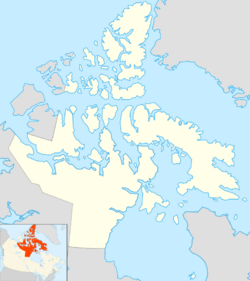Sybil Island facts for kids
| Geography | |
|---|---|
| Location | Frobisher Bay |
| Coordinates | 63°34′N 68°12′W / 63.57°N 68.20°W |
| Archipelago | Canadian Arctic Archipelago |
| Administration | |
| Territory | Nunavut |
| Region | Qikiqtaaluk |
| Demographics | |
| Population | Uninhabited |
Sybil Island is a small, uninhabited island located in the cold, northern part of Canada. It is one of many islands that make up the vast Canadian Arctic Archipelago. This group of islands is found in the Arctic Ocean and is known for its icy landscapes and unique wildlife. Sybil Island is part of the Qikiqtaaluk Region in Nunavut, which is Canada's largest and northernmost territory.
The island sits in Frobisher Bay, a large inlet of the Atlantic Ocean on the southeastern coast of Baffin Island. Baffin Island is the largest island in Canada and the fifth largest in the world. Sybil Island is located southeast of Iqaluit, which is the capital city of Nunavut. Iqaluit is a small but important community in the Arctic.
Contents
Where is Sybil Island Located?
Sybil Island is situated within Frobisher Bay. This bay is a long, narrow body of water that cuts into the southeastern part of Baffin Island. The bay was named after Martin Frobisher, an English explorer who explored the area in the late 1500s. The waters around Sybil Island are often very cold and can be covered in ice for much of the year.
Nearby Islands in Frobisher Bay
Sybil Island is not alone in Frobisher Bay. Many other islands are found close by. These include Crimmins Island, Jenvey Island, Kudlago Island, Pichit Island, and Sale Island. These islands, like Sybil Island, are generally uninhabited. They are part of the rugged and beautiful Arctic landscape.
What is the Canadian Arctic Archipelago?
The Canadian Arctic Archipelago is a huge group of islands in northern Canada. It includes more than 36,000 islands! These islands are mostly covered in tundra, ice, and snow. The archipelago is important for its unique environment and wildlife. It is also a key area for scientific research about climate change.
Life in the Arctic
Because Sybil Island is in the Arctic, it has a very cold climate. Winters are long and dark, with temperatures often dropping far below freezing. Summers are short and cool. Despite the harsh conditions, many animals and plants have adapted to life in the Arctic. While Sybil Island itself is uninhabited by humans, it might be visited by Arctic animals.
Animals of the Arctic
Animals like polar bears, seals, and various seabirds live in the broader Arctic region. These animals are specially adapted to survive the cold. For example, polar bears have thick fur and a layer of blubber to keep warm. Seals can swim in icy waters and find food. Many birds migrate to the Arctic in the summer to nest and raise their young.
Plants of the Arctic
The plants that grow in the Arctic are mostly small and low to the ground. This helps them survive the strong winds and cold temperatures. You might find mosses, lichens, small shrubs, and wildflowers. These plants grow quickly during the short summer months when there is continuous daylight.
Why are Arctic Islands Important?
Arctic islands like Sybil Island are important for several reasons. They are part of a unique ecosystem that is sensitive to changes in the environment. Scientists study these areas to understand climate change and its effects on the planet. The islands also hold cultural importance for the Inuit people, who have lived in the Arctic for thousands of years.
Protecting the Arctic Environment
The Arctic environment is very fragile. Human activities and climate change can have a big impact on it. Protecting uninhabited islands like Sybil Island helps to preserve the natural habitats for Arctic wildlife. It also helps to keep the Arctic ecosystem healthy for future generations.



